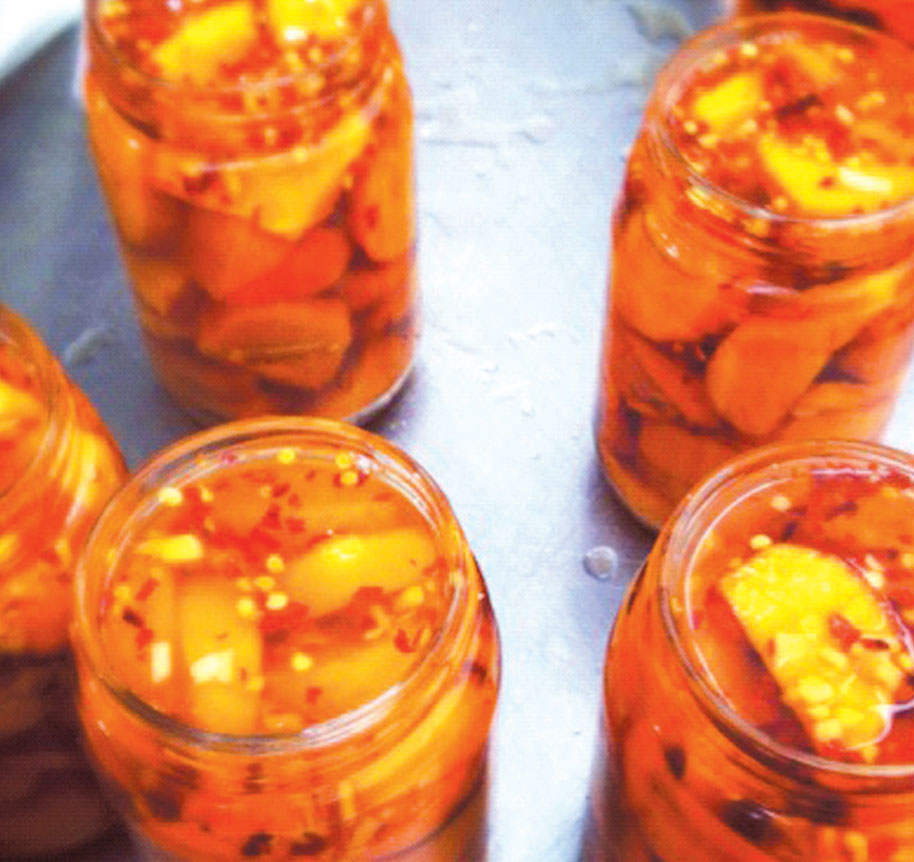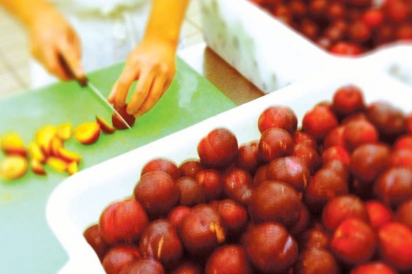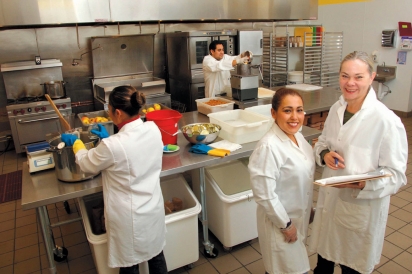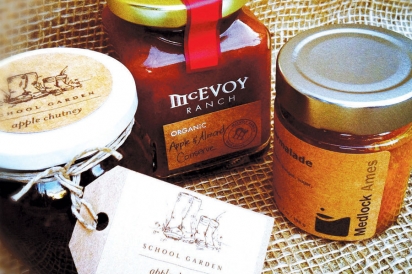Preserving Excess Bounty
In just over a year, the canning guru of Marin and Sonoma counties has almost outgrown the commercial kitchen space in San Rafael where she preserves the overabundance from many local farms—whether summer’s tomatoes, fall’s apples, winter’s lemons or spring’s green garlic.
Merrilee Olson is the edible innovator behind the budding business CAM FoodWorks. This certified organic small-batch, full-service canning company helps local growers turn a glut of fruits and vegetables into jams and jellies, conserves and chutneys, salsas and sauces. In doing so, Olson and her staff of five give this plethora of produce a shelf life beyond the growing season, add another source of revenue for farmers and provide an artisan product to consumers.
“There’s a crazy amount of demand for our services,” says Olson, whose client list includes McEvoy Ranch in northern Marin (jams and jellies), Medlock Ames Winery in Healdsburg (jams, butters and marinara sauce) and Bi-Rite Market in San Francisco, which has a farm in Sonoma (tomato sauce). Technically known as a co-packer, FoodWorks makes preserved products for clients whose own logo goes on the label. “We’re creating something new, so it’s both exciting and challenging,” she adds. “We want to make stars out of local farmers and their produce through these value-added products.”
For now, FoodWorks is still calling Community Action Marin (CAM) home. The nonprofit social services agency funds, among other services, food programs for local residents in need. The CAM kitchen feeds more than 600 children in the county’s Head Start program every day but used to shut down at 2pm. Last year CAM staff realized that the state-of-the-art space was an underutilized resource that could be put to good use and hired Olson to spearhead that effort.
A year later, Olson says FoodWorks has reached capacity in terms of equip- ment and storage space at the CAM facility. It is also close to becoming self- sustaining, she adds.
“I’ve got feelers out for a new location. Ideally we’d like to be on the border of the two counties—Novato or Petaluma would be good—we’re not in a hurry to move but we’ll probably relocate sometime at the end of the year or in early 2013.”
Small local food entrepreneurs, start-up edible enterprises and community nonprofits have all sought the services of FoodWorks. Kenny Rochford of School Garden called on Olson to produce apple chutney using gleaned produce from a Healdsburg farm as part of a fund-raising effort for a local school garden.
“As charitable endeavors go, I’d rather write a check for apple chutney than gift wrap,” jokes Rochford. The project proved popular; the group followed up with marmalade. “Gleaned fruit is tricky. There are variations in color, flavor and texture,” notes Rochford. “Olson is good at tweaking recipes to accommodate that.”
The business also turns out organic, minimally processed barbecue sauce, mayon- naise and hummus, and new products include Aunt Aggie’s Foods Tomato Smash (tomato relish), Zickles (zucchini pickles) and Veda Bar (Ayurvedic health bars).
“Olson is a food entrepreneur’s entrepreneur. She has helped guide us on every- thing from permits to packaging,” says Deacon Carpenter, owner of Veda Bar. “Due to her industry experience she’s deeply knowledgeable about the process of getting a fledgling food business running efficiently and profitably.”
While Olson, a former culinary director for Bon Appétit Management Corpora- tion, enjoys coming up with unique specialty products, she’s especially glad to be crafting quality artisan products out of produce otherwise destined for the compost pile. Olson works with clients on product concept, recipe development, production, packaging and labeling. Higher-value, less-perishable products can also help subsidize small-scale farmers whose profit margins are slim in the sustainable, organic produce world. Small-scale farmers she’s worked with include the Sonoma Farm Project, Tutti Frutti Farms in Lompoc (Santa Barbara County), and Lone Willow Ranch in Firebaugh (Fresno County), for whom she’s made a salsa recipe.
FoodWorks plays an invaluable role as an incubator for small food businesses, since the enterprise assumes many of the costs of regulatory hurdles and certifi- cation, commercial kitchen space and equipment and labor, which could prove prohibitive for small growers to take on individually, explains Ellen Roggemann, who oversees specialty food development and production at McEvoy Ranch. Roggemann works with Olson on recipes for the ranch’s line of products, includ- ing a recent batch of plum anise preserves. Even seemingly small matters—like a willingness and ability to work with whole, fresh fruit as it ripens versus fruit juice or frozen pieces—are big deals for modest-sized producers, Roggemann adds.
Each jar that comes out of the FoodWorks kitchen costs between $2 and $3.50 to produce, with a minimum order of 25 cases (by comparison, the average minimum in the industry is around 500 cases). Farmers pass on this cost to consumers, with products retailing around $8–$12 for the gourmet goodies, typically sold at the farms, at farmers’ markets around the Bay Area or in small specialty stores.
“I love that Olson is willing to work with our recipes and to execute them in small batches,” says Sam Mogannam, owner of San Francisco’s Bi-Rite Market. “She understands how important flavor and integrity are for us in the final product and is excited to work with us on creating something great. I also love that FoodWorks is just 30 minutes away, making it easier for us to visit and be part of the process.”
Olson, a Good Foods Award winner herself for her Middle- ton Farm raspberry preserves, hopes to see other small-scale food processors emulate FoodWorks’ effort to craft tasty preserved products the old-fashioned way. But in these lean financial times, it can be tough for food-based businesses to get off the ground.
Case in point: People’s Harvest in Petaluma, which was slated to open a plant to process fruits and vegetables from local farms, employing workers who face barriers to employment, such as disabled vets, the mentally ill and at-risk youth. In July, the social enterprise business was forced to abandon its construction plans due to the costs entailed, as well as worries about the strength of its potential customer base.
“We were looking forward to working with People’s Harvest to cut much of our fresh produce,” says Olson. “The cost of labor for prep is the most expensive part of what we do, and makes the end product more expensive for our clients and for the final customer.” Since People’s Harvest labor would have been government subsidized, it could have significantly lowered Olson’s costs.
And yet, despite such current economic realities, FoodWorks has thrived. Mogannam calls FoodWorks an example of food hubs that are popping up around the Bay Area and beyond, designed to save surplus, minimize waste and maximize profits. Efforts like his own, The Gleaning Project. Earlier this year FoodWorks created a green garlic pesto for Bi-Rite using surplus green garlic from a local farm. “People are realizing that in order for small farms to survive and be profit- able, they need to save money where they can and make any incremental money they can,” Mogannam says. “It’s so important for farmers to be able to find additional revenue streams to sustain their businesses, and this is one of the ways we can help them.”
Resources:
Cam FoodWorks: http://camarin.org/foodworks/
Aunt Aggie’s Foods: http://www.facebook.com/AuntAggiesFoods
Bi-Rite Market: http://www.biritemarket.com/
McEvoy Ranch: http://www.mcevoyranch.com/
Medlock Ames Winery: http://www.medlockames.com/
School Garden: http://www.schoolgardenwines.com/
Veda Bar: http://www.vedabars.com/










